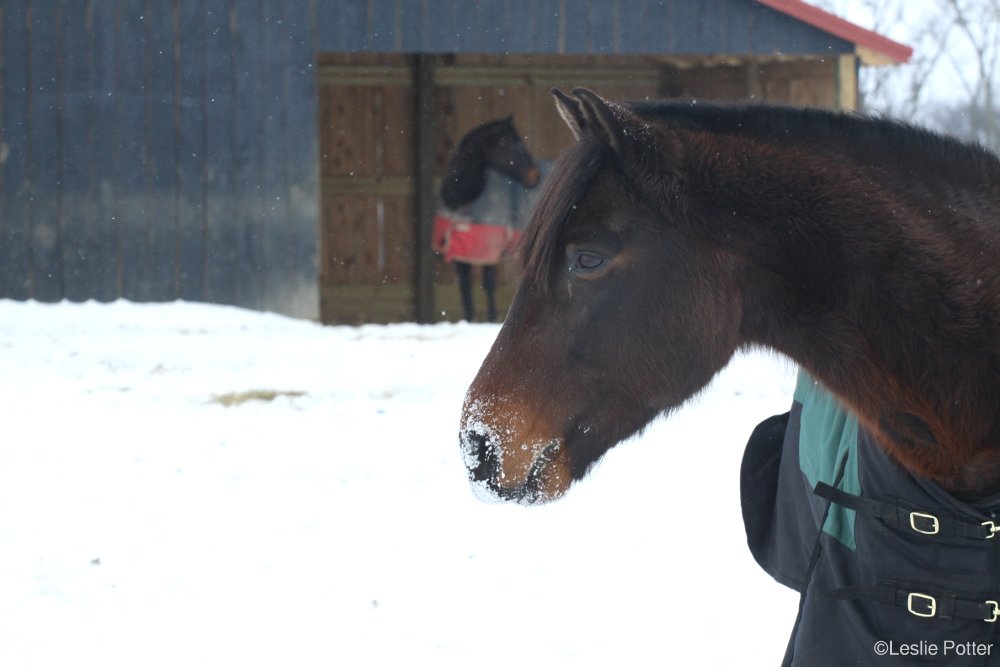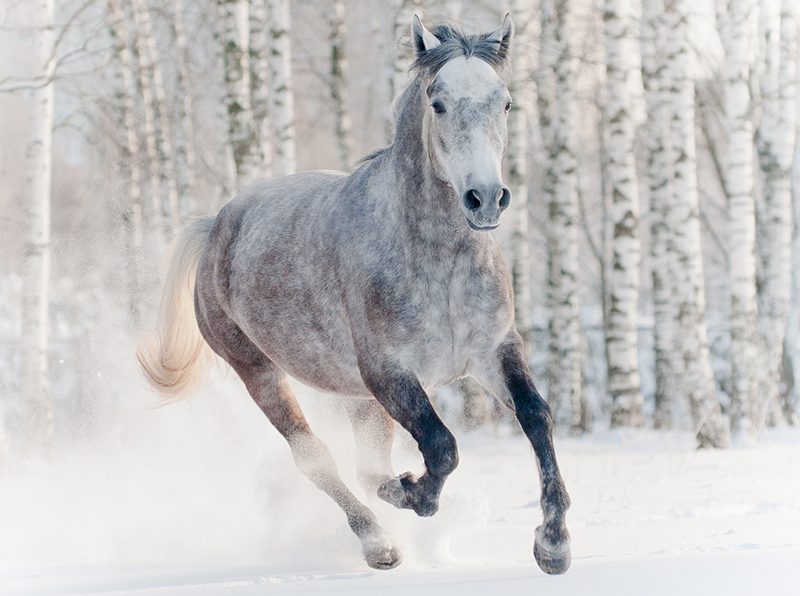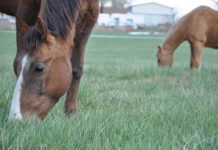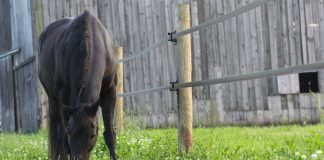As winter closes in around us, we have our warm winter clothing ready, hay in the barn, and the tractor and vehicles tuned up for the season. But what about our horses? True, we’re not as motivated in our riding pursuits with ice on the ground and frozen toes. But what can we do to winterize our horses and combat seasonal stresses? Here are some tips for how to winterize your horse.

1. Unfrozen Water
A horse that stops drinking is more likely to eat less or suffer from impaction colic. Water heaters keep water from freezing so you don’t have to keep breaking up ice multiple times a day. Tank heaters with elements that immerse to the bottom of the tank are safest.
Check that tank and water heaters are working and not passing electrical current into the drinking water. To horse-proof your heaters, encase electrical cords in plastic pipe or secure them out of reach out of inquisitive equine mouths.
Solar-powered, freeze-free water troughs are another option to keep water ice-free.
2. Preventive Veterinary Care
Although riding activities slow down in the winter, your horse’s health and general maintenance are still important. That is why it is important to do specific things to winterize your horse. Boosters for equine influenza and rhinopneumonitis are recommended twice a year to ward off respiratory infections caused by these viruses.
Strategic deworming programs should be based on fecal egg counts for each individual horse. An effective deworming program helps your horse get the most from his feed and reduces the risk of colic and weight loss. The fall months are a good time to treat for encysted small strongyles even if a fecal egg count comes back as negative. These parasites migrate into the intestinal wall and lie dormant until spring so limiting their numbers now benefits your horse’s intestinal health.
Your horse’s nutritional needs increase about 5 to l0 percent for every degree below freezing. To improve your horse’s ability to eat and digest his feed, have your horse’s teeth checked by your vet so dental care can be addressed.
3. Respiratory Health
In addition to keeping your horse current on respiratory vaccines, his living conditions also affect his respiratory health. Closed, stuffy barns with still air are a major winter health hazard.
Ammonia from urine collects in stalls and irritates the airways, leading to coughs and potential respiratory infection. Keep barn doors and windows open as much as possible to increase ventilation if your horse is stabled indoors.
As you winterize your horse barn, you can further safeguard respiratory health, protect the haystack and feed storage areas from excess moisture; this minimizes the risk of mold contamination that can cause allergic respiratory problems in horses.

4. Body Condition
A furry winter coat can hide a gaunt frame. Run your fingers across your horse’s ribcage periodically to check for fat coverage. Ideally, you can just feel the last two ribs with a light run of your hand.
Provide good-quality grass hay free-choice to help your horse generate heat from within. Fiber fermentation in the large intestine works like a wood stove inside your horse. During cold, wet spells, feed more hay to help your horse stay warm rather than loading him up with more grain.
Over time, grain will help put weight on a thin horse’s frame, but it does very little during an immediate need for warmth. If greater caloric intake is needed to maintain or increase body condition, supplement with a small amount of alfalfa hay and/or complete feed.
Fat supplements such as vegetable oil or stabilized rice bran provide an excellent and safe means of feeding more calories without the risk of carbohydrate overload of grain.
Vitamin and mineral supplements may be necessary to balance rations, particularly in young, growing, pregnant or senior horses. Provide a salt block at all times.
5. Hoof Care
While you may not be riding as much during the winter as in warmer weather, your horse’s feet still need attention. Plan on scheduling your farrier every six to eight weeks to maintain hoof health with a good trim.
It’s often a good idea to have your farrier pull your horse’s shoes for the winter. This allows the hooves to achieve a more natural, expansible state. Barefoot hooves easily shed ice and snow balls that collect in the feet. Some horses can’t tolerate being barefoot, however, so you’ll need to consider your horse’s unique needs.
If your horse can’t go barefoot and you plan to trail ride or turn him out on snow all winter, ask your farrier to add snow pads to his shoes. These plastic or rubber pads are shaped to pop out ice and snow so it doesn’t create dangerous “high heels.” Read more in “Winter Hoof Protection” below.
6. Gimme Shelter
We’ve all seen horses in the field standing with their backsides to the wind and snow, heads down, not moving as icicles form on their bodies. Although not absolutely necessary, shelter in these times is a bonus to keep your horse comfortable and to help him maintain body weight. Shelter from wind, rain or snow reduces metabolic demands on your horse, therefore reducing the need for more feed.
Any time of year, it’s ideal to have your horse turned out so he can maintain muscle tone and keep his joints moving. Besides heat generated from hay digestion, walking in the pasture is a means for a horse to keep himself warm. In inclement weather, a run-in shed shields him against wind and rain.
7. Blanketing
Once you decide to blanket, you will need to be committed to keeping up with it. Blanketing keeps your horse’s winter coat from growing as long or thick. It’s often a lot easier to let Mother Nature do her work by not interfering with your horse’s winter coat; simply provide shelter to get out of wet conditions.
If you ride hard and put your horse up as the temperature drops, his sweaty coat can be a problem. A damp coat doesn’t have insulating loft, allowing the horse to chill. Body clipping will help your horse stay comfortable, avoid overheating and cool out more quickly. But once the hair is removed, you must keep him properly blanketed as temperatures fluctuate.
The safest way to dry your horse’s coat is by covering him with a cooler made of wool, fleece or other wicking material for a few hours until he’s dry. This will keep heat in while pulling moisture out of the hair and allowing it to evaporate. When he’s dry, remove the cooler and brush out his coat to restore the loft. If you have the time and inclination, some have been known to use hair dryers to blow dry their horse’s damp coat.
Attentive winter care pays off for both you and your horse. He’ll maintain his body condition and health so that when spring rolls in, you’re both ready to get out and enjoy the warmer weather.
Winter Hoof Protection
Shoe Traction
If you keep your horse shod, borium caulks or metal studs can be added to the ground surface of the shoes to improve traction on slippery terrain. But there is a trade-off with caulks or studs: they can cause a horse’s foot to “stick” when ground isn’t slippery or covered with snow and ice. If the horse’s body continues to move while his leg remains stationary, this can result in strains, sprains, and more serious joint, tendon, or ligament injuries.
Hoof Boots
Rather than putting shoes back on for limited riding when you winterize your horse, consider using hoof boots when you do ride on hard, frozen ground that has no snow cover. These protect the hooves from excess wear while also protecting your horse’s soles from bruising; they are easily applied and removed for a single ride. Be aware that hoof boots don’t provide as much traction as a bare foot, and they can be incredibly slippery on ice and some snow conditions depending on snow depth and the ambient temperature. With snow and ice footing, it is best to let your horse be barefoot.
NANCY S. LOVING, DVM, is a performance horse veterinarian based in Boulder, Colo., and is the author of All Horse Systems Go.
This article about how to winterize your horse originally appeared in the December 2016 issue of Horse Illustrated magazine. Click here to subscribe!






